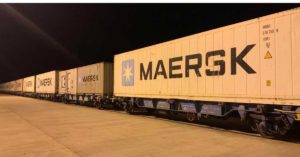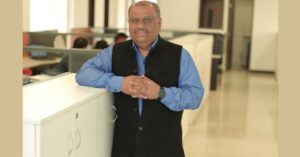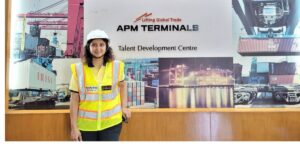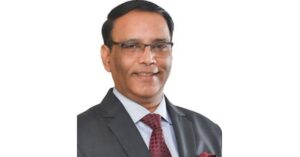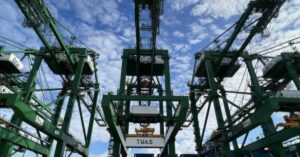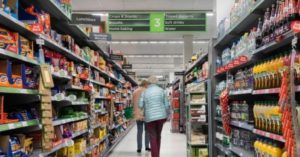“APMT Mumbai has been always around 2 million TEU capacity. The intention is we increase that by 10%. So, our capacity will become 2.18 to 2.2 million TEUs with infrastructure upgrade by February 2024,” informs Sunay Mukerjee, Chief Operating Officer, APM Terminals Mumbai
Give me a perspective of the container trade in general because I have been hearing from a lot of people that the demand seem to be still subdued and then it’s not picking up. So what is your experience as far as the container volumes are concerned?
I think we have to look at it from a trade perspective and also one part about the terminal is we are very much location dependent, which at times gives you advantage and also disadvantage. North-West India, to be honest, has had the privilege of seeing growth. And that has continued. So if you see the numbers for JNPA as well as for the overall North West India volumes have actually been steady and strong with Year on Year growth being visible from a port level perspective.
We also at GTI of course have been doing very well from our volume perspective, although we have been operating only one berth since February this year. Logically being at 50% would have been a good achievement from our numbers perspective. We have actually been at more than 70% of our numbers.
North West India is a little cocooned, if I might say from what you see in the overall global industrial perspective. From an overall global container trade, as you correctly pointed out, the numbers have softened during the perspective of this year if I’m looking at APMTs global portfolio, then YTD we are around 4 to 5% softer, compared to the same period last year. While things are expected to have normalized, there is hope that we have seen the bottom. And now we will see stability and growth quarter four heading into Christmas is always an important part because then for the Western trade, you get to see whether the demand is picking up or not. That would be important for us to observe whether there’s a bounce back or atleast a plateau that we can reach now.
You just mentioned you have been operating only one berth, is that because a lot of upgradation is happening? Can you give me an insight into what exactly is that fit for future? What does it mean to the end customer and what kind of equipment or a technology advancement is happening at APMTs?
We started operating in 2006 and our lease agreement started in 2004, as part of the lease agreements there is a lifespan of the equipment agreed upon after which we have to replace the equipment. There is a certain number of our ship to shore cranes and RMGCs that we’re operating and we needed to change. Then if we’re just changing them, why are we calling it fit for future.
That is because we decided that we will not do a like for like change. We have to look at what is the customers’ requirement. Here the customer is the shipping line. Over the period of time, the vessels that are coming in to the northwest part of India have been getting bigger and wider, more importantly. The customers have a very keen interest with all the new capacity and tonnage coming into the market to also deploy bigger vessels in India.
Our old cranes could only handle 18 wide. So they were not capable of handling the biggest vessels that call northwest part of India where you need to be at least 23 wide in order to handle those vessels. They also by default make the cranes taller to at least by 10 meters. Similarly, on the rail front. On the rail side we are moving from being single stack to double stacked. The height of our old RMGC’s did not allow, in the future also if we have the option of double stack trains coming in, we did not have the equipment to handle it. So we thought that when we get a chance to replace, we will not do a like for like, but we upgrade it. So that is one of the reason why this project is called Fit for future.
It is an investment of close to Rs. 840 crore that we are putting in this project. It is not just about bringing in all the new equipment that we are talking about, but at the same time, looking at our internal processes to drive higher efficiency and make it even better from our customer experience perspective. In order to accommodate these new equipment, the higher cranes, the wharves are also needed to be upgraded. So we are also changing the fenders and the boulders on the wharf so that the bigger vessels with higher displacement can be accommodated. We will have the capability of handling two large vessels within our 712 meter quay length.
In terms of capacity, what are the expectations once the whole upgradation is completed?
GTI or APMT Mumbai has been always around 2 million TEU capacity. The intention is we increase that by 10%. So, our capacity will become 2.18 to 2.2 million TEUs once we complete the civil work part of the project as well, which is expected to be completed by end of January early February.
And then we are able to accommodate two large vessels simultaneously with high productivity.
There are two parts to the whole project – two key milestones, one we actually achieved last week on 13th of September, when we reopened berth one for operations. So all the new cranes have been put back into operation. We have the first vessel calling on 13th of September. We actually have another one calling starting day after. So now we are getting back into operation.
Right now berth one cannot invite the largest vessels due to LOA perspective, because we still have the civil work ongoing. That civil work will get completed by end of January early February when the additional capacity by default becomes available to us.
For the last two years, 2022 and 2023, APM terminals has been the best performing terminal in terms of throughput and efficiency. Apart from equipment a lot of things contribute to the efficiency – people, processes. So can you tell me what are the unique things contributing to achieving this kind of efficiency?
It’s down to three things right people processes and systems. We call it our lean way of working, where we are focusing a lot on the people. This is following the old Kaizen concept of identifying waste in any work that we’re doing. Waste is anything that does not contribute to a benefit to the customer. So in part of the process if they’re doing something which is waste a frontline operator is capable of identifying it. We empower them to identify waste and then problem solve and come up with a solution.
We have something called asset digitization wherein all our assets and equipment are actually connected with a system. So in our planning room, which is like a control room, you can actually sit and observe what’s happening on each and every part of the terminal in real time. So for example, if you see the TT’s the internal trucks, these are the conveyor belt that is actually providing the containers to the cranes which are working on the vessel. We keep on focusing on the crane moves per hour, gross moves per hour, berth moves per hour, but in order to increase the productivity there, the smoother this conveyor belt works, the better will be the productivity and the efficiency. Now, how can we have a track of how much these movements are taking place? Where is the waste in this movement, your yard strategy, your TT movement strategy, all of these actually contribute towards that. Now with this asset digitization, we can see where are the bottlenecks. Is it in a particular block in the yard because a certain RTG has a lot more moves given to them or a lot more work given to them, which is actually disrupting this conveyor belt? How can we make it smoother? That is the constant focus and problem solving that is going on within the office to enable better movement in the front line. So that is the second part and definitely when it comes to system, right, the system is used to also train our operators.
We have probably the best operators in the vicinity because just about one and half month ago, we did something called mission 200 at the terminal. So that is the challenge. It was the middle of the monsoons, right, and we were working only with five cranes. We had a service coming in which had almost 4,300 moves on it. We wanted to achieve 200 port moves per hour. That is from the time the service calls us, the first lock in, first move, to the time the service actually sales out. If you average it out, we will do 200 moves per hour. In order to do that, all our five cranes needed to operate at almost more than 40 crane moves per hour, which meant we could not afford to have any equipment malfunction/breakdown. But all of these conveyor belts had to work supremely, you know, as smooth as possible. And we did it. Kudos to the team.
Now, green is the buzzword sustainable, the sustainable operations. So, what kind of sustainable initiatives you have at the APMT?
Maersk as a group along with the APM holding announced the launch of a company called C2x, which will be looking at supplying a huge quantum of green methanol production. And they would be based in a number of countries and India being one of them.
From APM terminals Mumbai or GTI, the way we approach it is on three buckets. The first bucket is “reduce”. There is a huge amount of carbon emission. How does that come? It comes from basically when the equipments are being used. If I can operate my equipment more efficiently reduce the running hours through efficiency reduction of waste in the process, then I will by default also be contributing towards the reduction of carbon emission.
The second is of course, “replace”. We have a number of equipment in the yard today which are diesel operated, like the RTGs, ITVs. This is where we have the opportunity to replace. Last year we worked with Siemens on a project and we hybridized two of our RTGs. So they basically became battery operated.
Then there is the third part – “reuse or renew,” which is where you focus on renewable energy.
We have now partnered with O2 Power to actually set up a captive power plant, which will be supplying us with 21.7 million units annually of green electricity. This will be located in the Vidharba region of Maharashtra. Once this is up and running, it will actually reduce the carbon emission by 44% of all our electrical equipment. Today, we consume almost 26 million units of electricity and that leads to almost 18 metric ton carbon emission. We are looking at reducing that by 44% in 8 to 10 months time.




